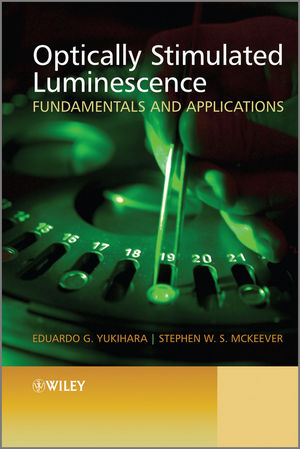Optically Stimulated Luminescence: Fundamentals and ApplicationsISBN: 978-0-470-69725-2
Hardcover
384 pages
February 2011
 This is a Print-on-Demand title. It will be printed specifically to fill your order. Please allow an additional 10-15 days delivery time. The book is not returnable.
|
||||||
Acknowledgments.
Disclaimer.
List of Acronyms.
1 Introduction.
1.1 A Short History of Optically Stimulated Luminescence.
1.2 Brief Description of Successful Applications.
1.2.1 Personal.
1.2.2 Space.
1.2.3 Medical.
1.2.4 Security.
1.3 The Future.
2 Theory and Practical Aspects.
2.1 Introduction.
2.2 Basic Aspects of the OSL Phenomenon.
2.2.1 Energy Levels in Perfect Crystals.
2.2.2 Defects in the Crystal.
2.2.3 Excitation of the Crystal by Ionizing Radiation.
2.2.4 Trapping and Recombination at Defect Levels.
2.2.5 Thermal Stimulation of Trapped Charges.
2.2.6 Optical Stimulation of Trapped Charges.
2.2.7 The Luminescence Process.
2.2.8 Rate Equations for OSL and TL Processes.
2.2.9 Temperature Dependence of the OSL Signal.
2.2.10 Other OSL Models.
2.3 OSL Readout.
2.3.1 Basic Elements of an OSL Reader.
2.3.2 Stimulation Modalities.
2.4 Instrumentation.
2.4.1 Light Sources.
2.4.2 Light Detectors.
2.4.3 Optical Filters.
2.4.4 Light Collection.
2.4.5 Sample Heaters.
2.5 Available OSL Readers.
2.5.1 Experimental Arrangements.
2.5.2 Automated Research Readers.
2.5.3 Commercial Dosimetry Readers.
2.5.4 Optical Fiber Systems.
2.5.5 Imaging Systems.
2.5.6 Portable OSL Readers.
2.6 Complementary Techniques.
2.6.1 OSL Emission and Stimulation Spectrum.
2.6.2 Lifetime and Time-Resolved OSL Measurements.
2.6.3 Correlations Between OSL and TL.
2.6.4 Other Phenomena.
2.7 Overview of OSL Materials.
2.7.1 Artificial Materials.
2.7.2 Natural Materials.
2.7.3 Electronic Components.
2.7.4 Other OSL Materials and Material Needs.
3 Personal Dosimetry.
3.1 Introduction.
3.2 Quantities of Interest.
3.2.1 Absorbed Dose and Other Physical Quantities.
3.2.2 Protection Quantities.
3.2.3 Operational Quantities.
3.3 Dosimetry Considerations.
3.3.1 Definitions.
3.3.2 Dose Calculation Algorithm.
3.3.3 Reference Calibration Fields for Personal and Area Dosimeters.
3.3.4 Uncertainty Analysis and Expression of Uncertainty.
3.4 Detectors.
3.4.1 General Characteristics.
3.4.2 Al2O3:C Detectors.
3.4.3 BeO Detectors.
3.5 Dosimetry Systems.
3.5.1 Luxel+ Dosimetry System.
3.5.2 InLight Dosimetry System.
3.6 Neutron-Sensitive OSL Detectors.
3.6.1 Development of Neutron-Sensitive OSL Detectors.
3.6.2 Properties of OSLN Detectors.
3.6.3 Ionization Density Effects.
4 Space Dosimetry.
4.1 Introduction.
4.2 Space Radiation Environment.
4.2.1 Galactic Cosmic Rays (GCR).
4.2.2 Earth’s Radiation Belts (ERB).
4.2.3 Solar Particle Events (SPEs).
4.2.4 Secondary Radiation.
4.3 Quantities of Interest.
4.3.1 Absorbed Dose, D.
4.3.2 Dose Equivalent, H.
4.3.3 Equivalent Dose, HT.
4.3.4 Effective Dose, E.
4.3.5 Gray-Equivalent, GT.
4.4 Health Risk..
4.5 Evaluation of Dose in Space Radiation Fields Using OSLDs (and TLDs).
4.5.1 The Calibration Problem for Space Radiation Fields.
4.5.2 Thermoluminescence, TL.
4.5.3 Optically Stimulated Luminescence, OSL.
4.5.4 OSL Response in Mixed Fields.
4.6 Applications.
4.6.1 Use of OSLDs (and TLDs) in Space-Radiation Fields.
4.6.2 Example Applications.
4.7 Future Directions.
5 Medical Dosimetry.
5.1 Introduction.
5.2 Radiation Fields in Medical Dosimetry.
5.2.1 Diagnostic Radiology.
5.2.2 Radiation Therapy and Radiosurgery.
5.2.3 Proton and Heavy-Ion Therapy.
5.3 Practical OSL Aspects Applied to Medical Dosimetry.
5.3.1 A Proposed Formalism.
5.3.2 Calibration and Readout Protocols.
5.3.3 A Checklist for Reporting OSL Results.
5.4 Optical-Fiber OSL Systems for Real-time Dosimetry.
5.4.1 Basic Concept.
5.4.2 Optical-Fiber OSL System Designs and Materials.
5.4.3 Readout Approaches.
5.5 Properties of Al2O3:C OSL Detectors for Medical Applications.
5.5.1 Influence Factors and Correction Factors.
5.5.2 Correction Factors for Beam Quality.
5.6 Clinical Applications.
5.6.1 Quality Assurance in External Beam Radiation Therapy.
5.6.2 Brachytherapy.
5.6.3 Measurement of Dose Profiles in X-ray Computed Tomography (CT).
5.6.4 Proton Therapy.
5.6.5 Fluoroscopy (Patient and Staff Dosimetry).
5.6.6 Mammography.
5.6.7 Out-of-field Dose Assessment in Radiotherapy.
5.6.8 Dose Mapping.
5.6.9 Final Remarks on Clinical Applications.
6 Other Applications and Concepts.
6.1 Introduction.
6.2 Retrospective and Accident Dosimetry.
6.2.1 Basic Considerations.
6.2.2 Methodological Aspects.
6.2.3 Building Materials.
6.2.4 Household Materials.
6.2.5 Electronic Components.
6.2.6 Dental Enamel and Dental Ceramics.
6.3 Environmental Monitoring.
6.4 UV Dosimetry.
6.5 Integrated Sensors.
6.6 Passive/Active Devices.
6.7 Other Potential Security Applications.
References.
Index.



